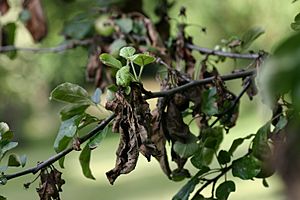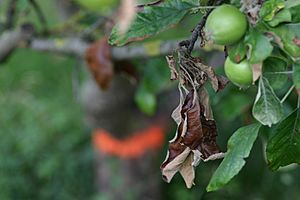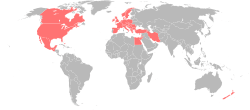Fire blight facts for kids
Fire blight is a serious plant disease that can spread very easily. It mostly affects plants in the rose family, like apple, pear, and hawthorn trees. This disease is caused by a tiny living thing called a bacterium named Erwinia amylovora.
If the weather conditions are just right, fire blight can quickly destroy a whole fruit orchard in a single growing season. It gets its name because the infected leaves and branches look like they have been scorched by fire.
Contents
How Fire Blight Spreads
Fire blight infections usually start in the spring. This is when trees have open blossoms and new, soft shoots and leaves are growing. The bacteria can enter the plant through these open blossoms or through small cuts and openings in the new growth.
Once inside, the bacteria multiply quickly. They block the plant's ability to move water and nutrients, causing parts of the plant to wilt and die.
What Happens to Infected Plants
When a plant gets fire blight, you might see several signs:
- Flowers and young fruits turn brown or black and then die.
- New shoots and leaves wilt and turn dark, looking like they've been burned. They often stay attached to the branch.
- Dark, sunken areas called cankers can form on branches and trunks. These cankers can ooze a sticky, milky liquid.
- The disease can spread quickly from one branch to another, and eventually to the whole tree.
Preventing and Treating Fire Blight
There is no known cure for fire blight once a plant is badly infected. This means that preventing the disease is very important.
Prevention Methods
- Spraying with special chemicals: Sometimes, farmers spray plants with special chemicals like streptomycin to stop new infections. However, using these too much can lead to bacteria becoming resistant to the chemicals, making them less effective over time.
- Using helpful bacteria: Scientists are also looking at using good bacteria or yeast to spray on plants. These helpful microbes can stop the fire blight bacteria from infecting new trees.
- Choosing resistant plants: Planting types of apple or pear trees that are naturally more resistant to fire blight can also help.
Treating Infected Plants
If a plant is already infected, the most effective way to stop the spread is to carefully cut off the diseased branches. These cut branches must be removed from the area and destroyed, often by burning them, to prevent the bacteria from spreading to other healthy plants. It's important to clean pruning tools after each cut to avoid spreading the disease further.
Images for kids
-
A Gala apple branch with “scorched” leaves after a severe fire blight infection.






